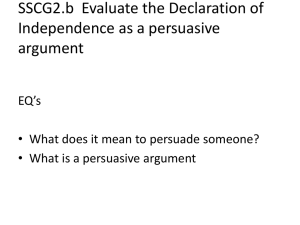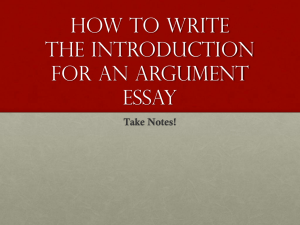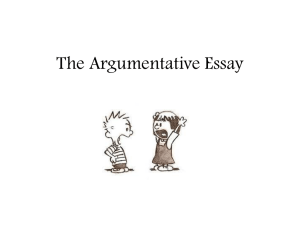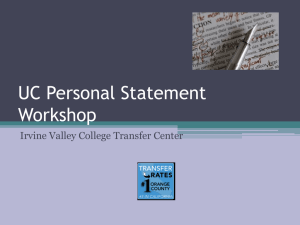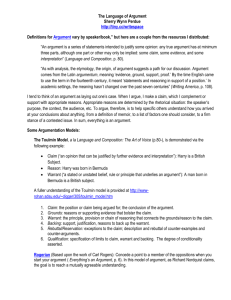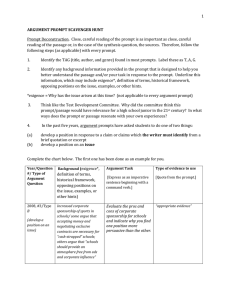Intro Argumentation and Persuasive Writing
advertisement
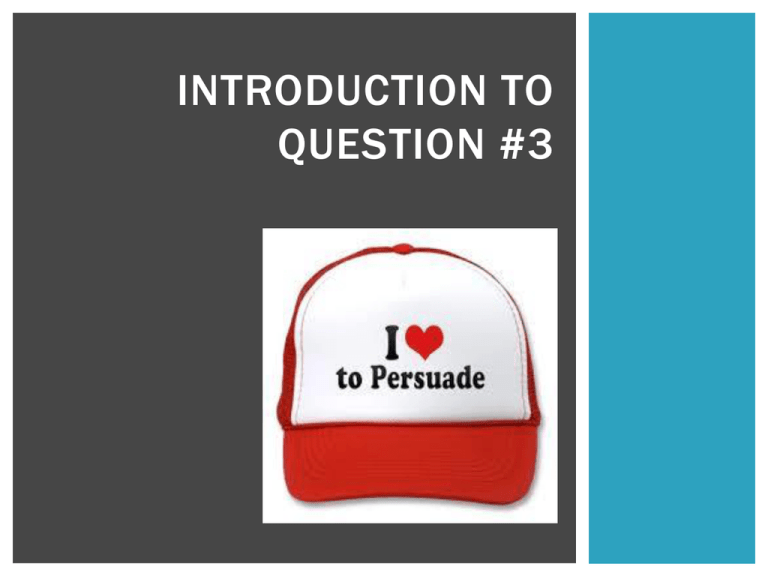
INTRODUCTION TO QUESTION #3 QUESTION 3: PERSUASIVE Unlike the other two essays you will be asked to write, this essay does not provide any text other than the prompt . Instead, your thesis is suppor ted by your own reading, obser vations, and experiences. In other words, this essay’s only suppor t is you; what you “know” is the textual suppor t. This essay can be dif ficult, as the question, regardless of what it is, presupposes that you have knowledge about the topic under discussion. The more you’ve learned about the world around you, and the more opinions you have formulated about it, the better. PERSUASIVE ESSAY OVERVIEW The language of the actual prompt may vary, but the task remains very similar. You may be asked to: Defend, challenge, or qualify a quotation about, or particular take on, a specific topic. Take a position of whatever debatable statement is provided in the prompt. Evaluate the pros and cons of an argument and then indicate why you find one position more persuasive than another. ARGUMENT Definition 1: An emotional, verbal fight in which people become angry, bitter, or dissatisfied with the person that you are opposing. Definition 2: A stance taken in support of an issue that can be supported, verified, or upheld by others. Screaming is not valid support. DEFEND, CHALLENGE, QUALIFY If you choose to defend what the text argues, you will give reasons that support the argument given. If you choose to challenge what the text argues, your reasoning will contradict the argument. If you choose to qualify what the text argues, you will agree with parts of the statement and disagree with others. Or, you might agree with the statement, but only under certain circumstances. Hope Solo contends defense wins championships. DEFEND, CHALLENGE, QUALIFY Defend: You agree with and support the argument presented. You are a proponent and on the affirmative side. Challenge: You disagree with the argument presented and refute it. You are an opponent and on the negative side. Qualify: You agree with part of the argument, but also see substantial flaws in logic. This is not the same as providing a counterclaim. QUALIFY According to AP readers students have the most dif ficulty when choosing to qualify an argument. The nuance required in an qualified argument is often extremely challenging in a timed situation. Often students make a very entry -level misunderstanding such as “Sontag is not qualified to discuss photography or ar t.” QUALIFY Balance can be very difficult to achieve. However, our recommendation is that every student attempt one qualification essay during second trimester in order to get feedback. MORAL OF STORY? PICK A SIDE. Just to reiterate a final time: Students are usually better of f choosing to “defend” or “challenge” an argument. You do want to address the opposing viewpoint, but usually it is best to do that in a counter claim paragraph. OTHER “TECHNICAL” TERMS Evidence is a piece of information that supports a claim Hard Facts Quotes Stats/Data Examples are types of evidence and come in the form of Personal Experience Analogies Logical Hypotheticals GOING SOMEWHERE? Developing an argument means the argument needs to move forward You can’t just make one little point and assume you are developing it by adding six redundant examples Several well-ordered claims (points) give your argument a dynamic sense of movement. INTRODUCTION PARAGRAPH Hook Attention getter. Use an appeal. Background Consider your audience and provide background information they are likely to need. Thesis (claim) Clearly state your position and preview the claims (points). SUPPORTING PARAGRAPHS State your supporting claim Back it up with evidence and examples. Make it impactful by explicitly relating supporting points back to the thesis. At some point you will need to acknowledge the other side. Ideally, this is through the use of a counter-claim paragraph. CONCLUSION Include a Call to Action Review your thesis and major body points Leave your audience with a lasting impression COMMON ERRORS Not taking a clear position or wavering between positions. Substituting a thesis-oriented expository essay for an argumentative essay. You need to persuade, not just inform . Being reluctant to engage in verbal combat because "everyone's entitled to his or her own opinion," so there's nothing to argue about. Discussing details too generally. There is power in specificity. Lacking clear connections between claims and the data, and the warrants needed to support them Providing a rhetorical analysis of the passage or commenting on the speaker’s style instead of arguing a point CHIEF READER ON UNDERSTANDING THE WORLD AROUND YOU. “Through extensive reading, discussion, and writing, students will come to recognize a world larger than their own immediate experience . …Teachers need to help students understand the usefulness of a global view, to increase their awareness of the world beyond their own. Students need to recognize that examples drawn from a wider world may be stronger [than their own personal experiences] ...When relating their personal experiences, students need to be mindful of the public nature of most argumentation. In such a context, the primary purpose of a personal narrative is rhetorical, not confessional .” TODAY’S PROMPT Question 3 (Suggested time—40 minutes. This question counts for one -third of the total essay section score .) In his 2004 book, Status Anxiety, Alain de Botton argues that the chief aim of humorists is not merely to entertain but “to convey with impunity messages that might be dangerous or impossible to state directly.” Because society allows humorists to say things that other people cannot or will not say, de Botton sees humorists as serving a vital function in society. Think about the implications of de Botton’s view of the role of humorists (cartoonists, stand -up comics, satirical writers, hosts of television programs, etc.). Then write an essay that defends, challenges, or qualifies de Botton’s claim about the vital role of humorists. Use specific, appropriate evidence to develop your position. BASELINE PROMPT Background: For years corporations have sponsored high school sports. Their ads are found on the outfield fence at baseball parks or on the walls of the gymnasium, the football stadium, or even the locker room. Corporate logos are even found on players’ uniforms. But some schools have moved beyond corporate sponsorship of sports to allowing “ corporate partners” to place their names and ads on all kinds of school facilities —libraries, music rooms, cafeterias. Some schools accept money to require students to watch Channel One, a news program that includes advertising. And schools often negotiate exclusive contracts with soft drink or clothing companies. Prompt: Some people argue that corporate partnerships are a necessity for cash-strapped schools. Others argue that schools should provide an environment free from ads and corporate influence. Using appropriate evidence, write an essay in which you evaluate the pros and cons of corporate sponsorship for schools and indicate why you find one position more persuasive than the other. PROMPT Some people argue that corporate partnerships are a necessity for cash-strapped schools. Others argue that schools should provide an environment free from ads and corporate influence. Using appropriate evidence, write an essay in which you evaluate the pros and cons of corporate sponsorship for schools and indicate why you find one position more persuasive than the other.



